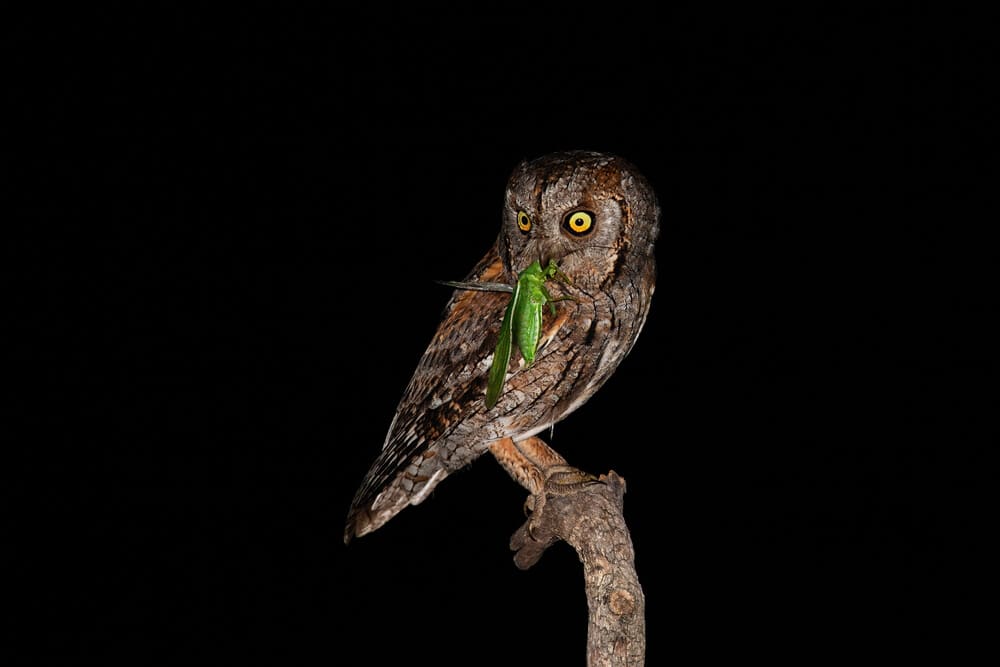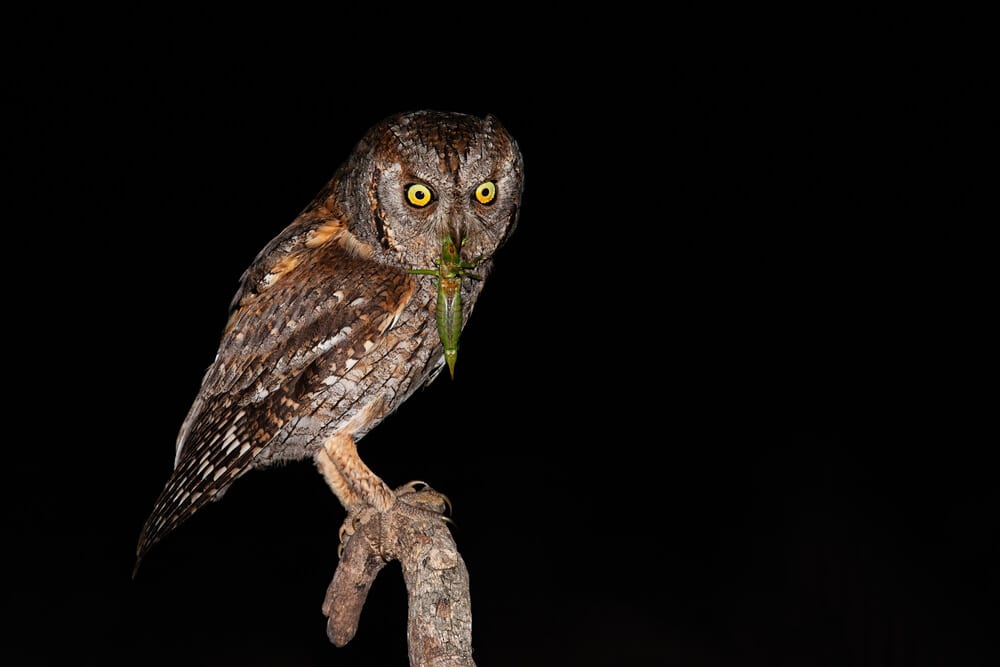From the swooping flight to the smart snatch, owls are magnificent birds that have a way of captivating our attention.
But have you ever stopped to wonder what’s on their dinner plate? Would you believe grasshoppers make up a whopping 70% of some owls’ diets? Read on till the end to explore more!
Do Owls Eat Grasshoppers?

Yes, some owls do love to munch on grasshoppers, especially those dwelling in grasslands, or deserts.
The burrowing owl, often found in grasslands, has a special fondness for grasshoppers. In fact, around 93% of their diet consists of insects, with 75% of that being grasshoppers. Fascinating, isn’t it?
And to be specific, Grasshoppers make up nearly 70% of the burrowing owl’s total diet.
Did you know that as grasshoppers become more prevalent in an owl’s diet, especially burrowing owls, they shift to eating more during the day? However, they remain mostly nocturnal during the breeding season.
Sadly, pesticides can affect the availability of grasshoppers in agricultural lands, causing owls to forage in non-cultivation areas.
Grasshoppers aren’t just abundant; they’re nutritious. Packed with protein and other nutrients, they are a complete meal for an owl. Whether swallowed whole or torn into bite-sized morsels with sharp beaks, grasshoppers offer a nourishing feast.
| Grasshopper Nutrients: | Percentages: |
| Protein | 40% |
| Fat | 43% |
| Fiber | 13% |
Some grasshopper-loving owl species include the short-eared owl, the long-eared owl, the little owl, and the scops owl.
What Do Owls Eat?
Owls are true carnivores with quite an appetite! They dine on a variety of prey, tailoring their menu to their specific size, species, and habitat.
Rodents, reptiles, amphibians, birds, fish, and insects — all of these food groups form part of an owl’s diet. Whether you find them in dense forests, sweeping grasslands, or by a shimmering river, their choice of meal changes accordingly.
Owls are renowned for their incredible senses. They can spot a meal from afar using their sharp eyesight, even in low light. With their acute hearing, they can pinpoint the faintest rustle in the grass. Together, these keen senses make them masterful hunters.
When it’s mealtime, owls don’t fuss with dining choices. They’ll either swallow their prey whole or tear them into large, manageable pieces. Their unique digestive system takes care of the rest.
Want to dive into specifics? Here’s a table showcasing some well-known owl species and their favorite munchies:
| Owl Species | Primary Diet |
| Barn Owl | Rodents |
| Snowy Owl | Lemmings |
| Great Horned Owl | Rabbits |
| Burrowing Owl | Insects |
| African Fishing Owl | Fish |
How Do Owls Catch Grasshoppers?
Ever wonder how owls manage to snag those speedy grasshoppers? Let’s take a flight through their various hunting techniques.
Some owls prefer to fly low over the ground, eyes keenly scanning for their next meal. They’ll stretch out their talons and snatch up those grasshoppers in a split second.
Others might perch on a branch, patiently waiting. With a sudden swoop, they’ll nab a grasshopper right off the ground. Talk about precision!
Walking on the ground isn’t beneath these majestic birds either. Using their beak, they’ll casually pick up grasshoppers as if plucking flowers.
Catching grasshoppers is no small feat. These insects are quick to jump and fly away. But owls have a bag of tricks to ensure they rarely miss.
Ever notice how quiet an owl’s flight is? That’s their secret strategy! Their silent flight, paired with powerful legs and hooked claws, makes them expert raptors.
Owls’ necks are not only a marvel to behold but a crucial part of their hunting technique. The flexibility allows them to angle their attacks just right.
As the sun sets and the air cools, grasshoppers become less active. Owls have learned to take advantage of this. They will fly to tall grasses and pick those grasshoppers right off the stalks.
Some burrowing owls also have a special love for grasshoppers hiding in shocks of oats. All in all, grasshoppers to owls is just like coffee is for humans.
So owls don’t miss any opportunity whenever they spot a grasshopper as an easy target hanging around!
Owl’s Diet: Pros And Cons Of Eating Grasshoppers
So, why do owls munch on grasshoppers? And are there any downsides to this snack? Let’s dive into the details.
Pros of Eating Grasshoppers
- Easy Pickings – Grasshoppers are everywhere, especially in grasslands.
- Energy Boost – Grasshoppers are full of nutrients that help keep owls going strong.
- Balanced Diet – Owls don’t just eat for fun. Grasshoppers help them get the essential nutrients they need. It’s a well-rounded meal on wings.
Cons Of Eating Grasshoppers
- Hidden Dangers – Sometimes, grasshoppers eat plants sprayed with insecticides. When owls eat these grasshoppers, they might get a dose of something harmful.
- Unwanted Guests – Grasshoppers may carry parasites or toxins. It’s like biting into an apple and finding a worm, only worse for the owls.
What Other Insects Do Owls Eat?
Besides grasshoppers, owls relish a variety of insects. Crickets, beetles, moths, caterpillars, ants, termites, spiders, scorpions, and centipedes are all on the menu.
Insects are particularly important for small and medium-sized owls living in arid or tropical regions.
For instance, the elf owl, pygmy owl, tawny owl, and spotted eagle owl are particularly fond of insects.
Do Owls Play A Role In Controlling Insect Population?
Yes, Owls help keep the insect population in check, acting as natural pest controllers. They balance the ecosystem and prevent insect outbreaks that can damage crops.
Final Thoughts
So, do owls eat grasshoppers? Yes, absolutely! In the world of owls, the grasshopper is more than a mere snack. It’s an essential part of their diet
The next time you’re enjoying a peaceful evening outside, and you hear the gentle hoot of an owl, remember: they might just be enjoying a tasty insect dinner.
References:
- James, Paul C., and Glen A. Fox. “Effects of some insecticides on productivity of Burrowing Owls.” Blue Jay 45.2 (1987).
- Haug, Elizabeth Anne. Observations on the breeding ecology of Burrowing Owls in Saskatchewan. Diss. University of Saskatchewan, 1985.
- “What Are the Health Benefits of Grasshoppers?” WebMD, 3 June 2022, www.webmd.com/diet/what-health-benefits-grasshoppers.


